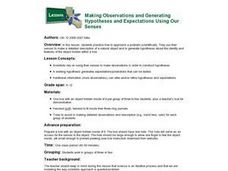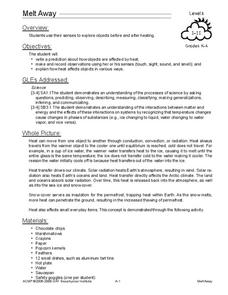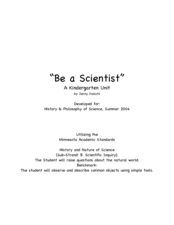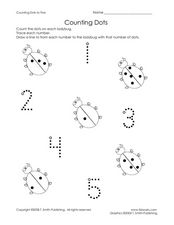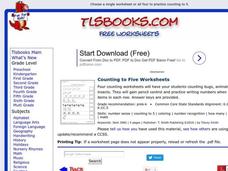Curated OER
Mystery Box
Students predict what mystery objects are based on how they feel. In this sense of touch lesson plan, students reach inside a box and make a guess about the object inside. Once students record their predictions, the objects are revealed....
Curated OER
Making Observations and Generating Hypotheses
Students practice how to approach a problem scientifically. They use their senses to make a detailed description of a natural object and to generate hypotheses about the identity and features of the object hidden within a box.
Curated OER
Melt Away
Students explore objects before and after heating using their senses. In this matter and energy lesson, students experiment with a variety of objects and use their senses (except taste) to make predictions and record observations...
Curated OER
Ears Here!
Learners participate in an interactive video to review the five senses. They perform hands-on activities to test their sense of hearing and play a hearing game from the Internet.
Curated OER
Be a Scientist: A Kindergarten Unit
Students conduct observations using their five senses. In this science lesson, students describe different states of matter. They investigate the factors affecting mold growth.
Curated OER
Fun With Adhesives
Students observe, measure, and record the properties in making objects stick together using science tools. In this science lesson, students explore with their senses while mixing flour and water. Additionally, students share their...
Curated OER
Number Sense
In this ordinal numbers practice activity, students respond to 5 questions that require them to identify the first, second, third, fourth, and fifth fish in 5 lines of fish.
Curated OER
I Can See and Feel the Change in the Seasons
Students use their senses to investigate the changes in the seasons. They discuss how the Earth moves around the sun and its tilt. They practice using new vocabulary and examining the different seasons.
Curated OER
The Physics of Sound: How We Produce Sounds
Young scholars are introduced to how they produce sounds. In groups, they participate in experiments in which they measure sound and identify their five senses. Individually, they make their own musical instruments using different...
Curated OER
Sense-Ability
Students use comparisons, graphing, patterning, and sorting, and develop language skills as they explore the five senses.
Curated OER
Count, Trace, and Print Numbers 1 to 20
The first of these four pages deals with numerals 1 - 5, and subsequent pages cover the following sets of five numerals. For each, one or two dominoes display the number of spots, dotted lines with arrows instruct how to write the...
T. Smith Publishing
Counting Dots to Five
Cute as a bug in a rug! This task involves tracing dotted-line numbers, counting the spots on ladybugs' backs, and then drawing a line to match the insect to the corresponding numeral. This is ideal to include in your homework packets...
Curated OER
What Food Is It?
Students close their eyes and taste foods without using the sense of sight to identify the foods. They record what they think the food is that they tasted.
Curated OER
Nature Walk
Students explore nature artists and participate in a nature walk. In this art/nature lesson, students discuss things artists use from nature then talk a walk to find some of the same things. Students look for different shapes...
Curated OER
On Your Mark, Get Set, Read!
Are your beginning readers trying to build fluency? Use this activity to teach them how to monitor their reading fluency. First they get a sentence to practice with, reading it to their partner once and rereading it silently five times....
Curated OER
Count, Trace, and Print Numbers 1-5
In this number practice activity, students count the dots, trace the numbers using the stroke patterns, and then print the numbers three times.
Curated OER
In The Dark
Students go on a "trust walk" during which one student is blindfolded and led around by his/her partner.
Curated OER
Can You Tell By Touch?
Students feel inside a bag and use only their sense of touch to describe and identify one of the objects that is inside the bag.
Curated OER
Our Daily Five
Students explore the food pyramid through a class discussion, hands-on experience with food items, and a floor game that helps them to identify the food group involved. Lesson extensions include the use of play money, art, and dance.
T. Smith Publishing
Counting to Five
Rows of cartoon-style animals are displayed for your mini mathematicians to count. At the end of each row, they write the number of animals counted. Numbers only range from 1 to 5, so this is most appropriate for absolute beginners. Cute!
ARKive
Nocturnal Animals
How do those nocturnal animals see in the dark? This perplexing question does have an answer. First, little ones use their sense of touch to determine the name of a mystery object, then they listen closely to identify various animals by...
Curated OER
Guesstimate? NO Estimate!
Students discover the advantage of estimation over simple guessing using number relationships. They also discover how useful a mathematical tool estimation is in everyday life.
Curated OER
Language Arts: Scavenger Word Hunt
Participate in a scavenger hunt to find objects beginning with a particular letter sound and take digital photos of them with your scholars. Using software, they find word pictures beginning with particular letters and locate picture...

